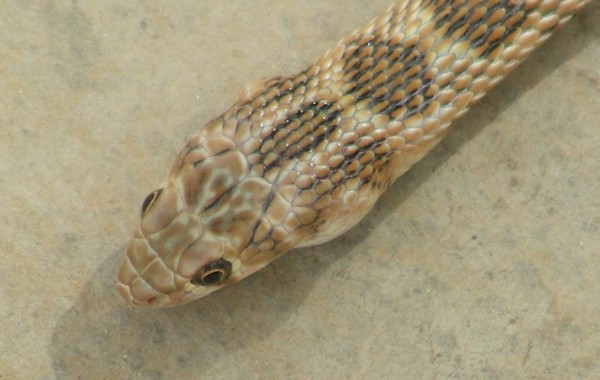
Hypnale is a genus of venomous pit vipers endemic to Sri Lanka and southwestern India. Three monotypic species are currently recognized. All members have more or less upturned snouts that produce a hump-nosed effect.

Ahaetulla prasina is a species of snake in the family Colubridae native to southern Asia. Its common names include Asian vine snake, Boie's whip snake, Gunther's whip snake, and Oriental whip snake.
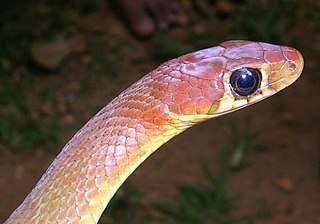
Hebius monticola is a harmless colubrid snake species endemic to the Western Ghats of India. They are especially well known from the Kodagu and Wayanad regions of the Western Ghats.
Cantoria violacea, commonly known as Cantor's water snake, is a species of snake found in tropical Asia. It is named in honor of the 19th century herpetologist Theodore Cantor.

Lycodon aulicus, commonly known as the Indian wolf snake, is a species of nonvenomous snake found in South Asia and Southeast Asia. Early naturalists have suggested its resemblance to the venomous common krait as an instance of Batesian mimicry.

Rhabdophis plumbicolor, commonly known as the green keelback or the lead keelback, is a species of nonvenomous snake in the family Colubridae. The species is endemic to parts of Asia.

The western kukri is a non-venomous species of snake found mainly on the forest floor in the Western Ghats mountain range of India, usually south of the Goa Gap, a pass in the mountain range. The snakes are brown above with a dark brownish patch on the head that appears like a bird silhouette on the head. The underside is patterned in yellow and black.
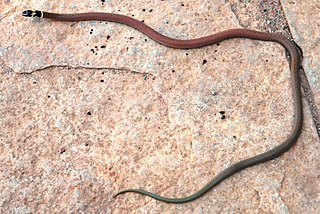
Sibynophis subpunctatus, commonly known as Duméril's black-headed snake or Jerdon's many-toothed snake, is a species of nonvenomous colubrid snake endemic to Bangladesh, India and Sri Lanka.

Hydrophis melanocephalus, commonly known as the slender-necked sea snake, is a species of venomous sea snake in the family Elapidae.

Coelognathus helena monticollaris is subspecies of a nonvenomous constricting snake in the family Colubridae. The subspecies is native to south Central Asia.
The Cameroon racer, Poecilopholis cameronensis, is a species of fangless venomous snake endemic to Africa. Poecilopholis is a monotypic genus created for this species.
Amblyodipsas unicolor, commonly known as the western glossy snake or the western purple-glossed snake, is a species of rear-fanged snake in the family Atractaspididae. It is one of the better known species in the genus Amblyodipsas.
Aparallactus niger is a species of venomous rear-fanged snake in the family Atractaspididae. It is endemic to Western Africa.

Aparallactus lunulatus, or the reticulated centipede-eater, is a species of venomous rear-fanged snake in the family Atractaspididae, which is endemic to Africa.
Aparallactus modestus, or the western forest centipede-eater, is a species of venomous rear-fanged snake in the Atractaspididae family,
Aparallactus nigriceps, or the Mozambique centipede-eater, is a species of venomous rear-fanged snake in the family Atractaspididae.

The thickhead ground snake is a nonvenomous colubrid snake species, with no recognized subspecies, endemic to central Colombia.
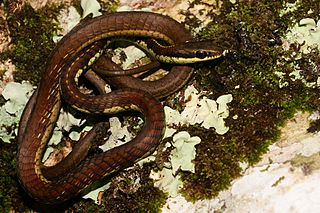
Dendrelaphis schokari, also known as the common bronze-back or Schokar's bronzeback, is a species of non-venomous arboreal snake in the family Colubridae. The species is endemic to Sri Lanka.
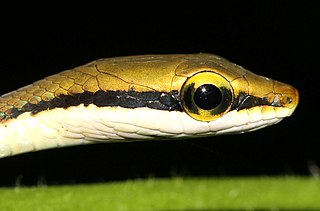
Dendrelaphis girii, or Giri's bronzeback tree snake, is a species of diurnal, arboreal, Colubrid snake endemic to the Western Ghats of southwestern India.

Rhadinella xerophila is a very rare snake endemic to the seasonally dry forests and thornscrub of the Middle Motagua Valley in Guatemala. This snake is characterized by its orange auburn head and its small size. This species is related to the group of Rhadinella that have dark dorsal coloration, which mostly or completely obscures a pattern of longitudinal striping characteristic of the majority of species of Rhadinella. This species has dark gray, almost black, dorsal coloration with barely discernible slightly darker striping. Top of the head is mostly blackish with irregular auburn-orange markings on the internasals, prefrontals, frontal, parietals, loreals, postoculars, temporals, and two ultimate supralabials. Most conspicuous features are an orange-auburn Y-shaped marking along frontal-parietal and interparietal sutures, followed by an orange nuchal collar. The closest relative of the new species, based on morphological similarities, appears to be Rhadinella pilonaorum, which occurs in a relatively mesic habitat of pine-oak forest located about 90 km southwest from the type-locality of the new species. It has been recorded only at Heloderma Natural Reserve, El Arenal, Zacapa, Guatemala.



